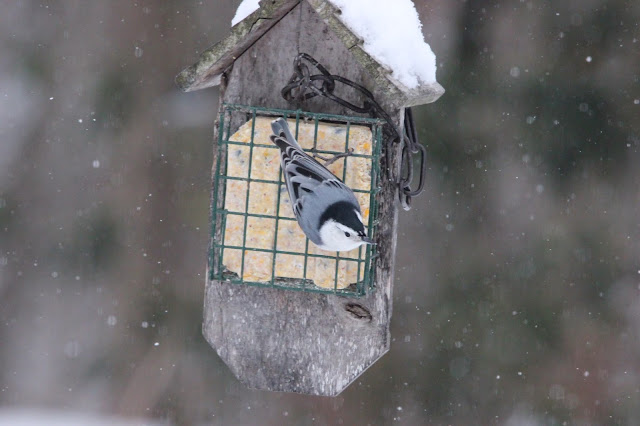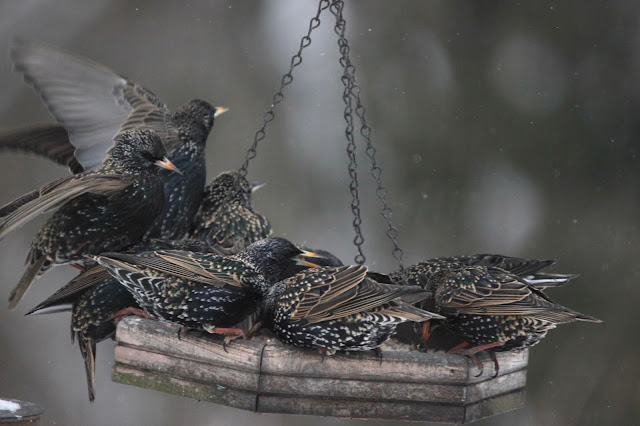 |
| White-Breasted Nuthatch enjoying some mealworms. |
 |
| Northern Cardinal and an Eastern Bluebird visiting a mealworm feeder. |
 |
| White-Breasted Nuthatch feeding upside down on the suet feeder. |
Molly and I visited the home of her parents Mark and Kim along with Molly's sister Meagan, our brother-in-law Seth, and our cute nephew Elisha (who Uncle Lucas hopes to teach how to love birds) for Super Bowl Sunday. At their house, we were able to take a few pictures of the bird visitors to their superb feeding setup.
 |
| A male House Finch perched on the feeder. |
 |
Two Eastern Bluebirds enjoying some mealworms.
|
A few of the visitors to the feeder are unique only to winter. Dark-Eyed Juncos and American Tree Sparrows find their way back to lower Michigan in late fall and leave for the the boreal forest of Canada in the early spring. American Tree Sparrows make an even longer journey. They will leave us in the early spring for the far northern reaches of Canada and Alaska. Oddly enough, American Tree Sparrows don’t typically nest in trees, but instead nest on the tundra grass north of the boreal forest.
 |
| Our winter migrant, the Dark-Eyed Junco, perching on the bird feeder pole. |
 |
| A pair of Dark-Eyed Juncos sharing a meal at the platform feeder. |
 |
| An American Tree Sparrow feeding on the ground. |
Eastern Bluebirds are a stunning year round visitor to the Dahmer’s backyard. The Dahmer’s consistent feeding of meal worms year round and the likelihood of nest boxes in the vicinity has led to these beautiful birds being a regular visitor and a likely successful breeder in this area. These birds are slowly recovering from a loss of habitat and nesting areas (due to the invasive House Sparrows, more on them later). A big aid in the recent success of these birds is a concerted effort by bird lovers to construct nest boxes for these birds.
 |
| An Eastern Bluebird enjoying a meal with some Dark-Eyed Juncos and an unwelcomed female House Sparrow. |
 |
| A male Eastern Bluebird enjoying a feast of mealworms. |
 |
| An Eastern Bluebird perched on a snowy branch. |
The Carolina Wren is a surprising visitor to their feeder. These birds are found in more abundance further south of us, but are beginning to be more successful in lower Michigan. These vibrant colored wrens are a favorite of mine to see in the winter and I am especially fond of their cute long tails that stick up high in the air.
 |
| A Carolina Wren posing for the camera. |
 |
| A Carolina Wren and a Dark-Eyed Junco sharing a quick meal. |
The most infamous visitors to the feeders were House Sparrows and European Starlings. Some foolish bird lovers introduced House Sparrows to New York City in the 1850s and to Salt Lake City and San Francisco in the 1870s. These aggressive birds that thrive in almost all environments (even in urban environments) have devastated a lot of the native species in America, including Eastern Bluebirds. House Sparrows often evict native birds out of nests and can even kill them. Fortunately for bluebirds, specific nest boxes especially designed for bluebirds prevents this activity from house sparrows.
 |
| A male House Sparrow, who was a successfully introduced species to North America. |
European Starlings were introduced by some foolish lovers of Shakespeare in New York City. These Shakespeare adorers wanted birds mentioned in Shakespeare’s works to be in America, and they began their quest by releasing a few starlings in New York City in the 1890s. The European Starling has since turned into the one of the most abundant birds in North America. These aggressive birds have led to declines in Bluebirds and Woodpeckers, and a first hand example that I have seen was when a starling in our backyard kicked out a red bellied woodpecker from its nest after the woodpecker spent days making the cavity. These birds can decimate fields filled with young crops and thus are viewed as a pest by farmers. These birds certainly have their beauty (especially when Starlings form a murmuration while flying) but if you desire to hate any bird the Starling and House Sparrow should be at the front of your list.
 |
| A flock of European Starlings invading the platform feeder. |
 |
| A few European Starlings enjoying a meal on the platform feeder. |
Once the sun set and the birds finished their feast, we were able to have our own feast of tasty smoked ribs, smoked chicken wings, homemade macaroni and cheese, homemade coleslaw, chips/queso, and cucumber/tomato salad. Although the bird sightings were fun and the food was delicious, I can say what truly made this day special to me is that we were able to spend a Sunday afternoon and evening with our awesome family. It is hard to beat a fun day catching up with our parents/siblings and watching our active nephew Elisha entertain us with his fun personality.
 |
| A Mourning Dove slowly eating its all-you-can-eat buffet. |
 |
| A White-Breasted Nuthatch racing off with a mealworm. |





















Great pictures, Lucas! That first pic of the dark-eyed junco looks really nice.
ReplyDeleteI had no idea house sparrows were so evil! I should get some bluebird houses for my mom. I see sparrows out there all the time, but I'm sure she'd rather see some Easterns.
Thanks Corey!
DeleteThanks for sending me the email of your blog posts today bud! Glad to see you could do some birding from your in-laws and hopefully you'll convince Elisha to be a birder too. :)
ReplyDeleteI never knew that I wanted to hate a type of bird until now. Thanks Lucas.
ReplyDelete